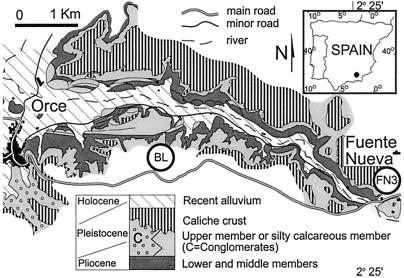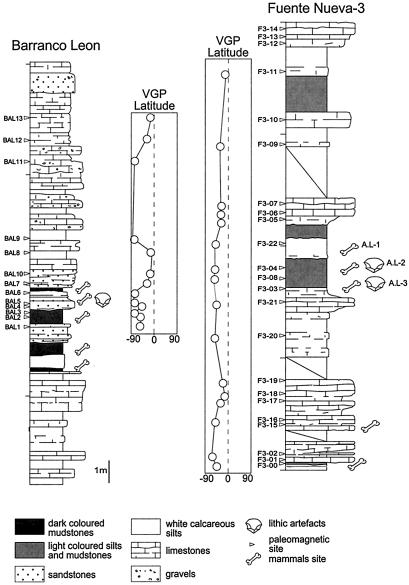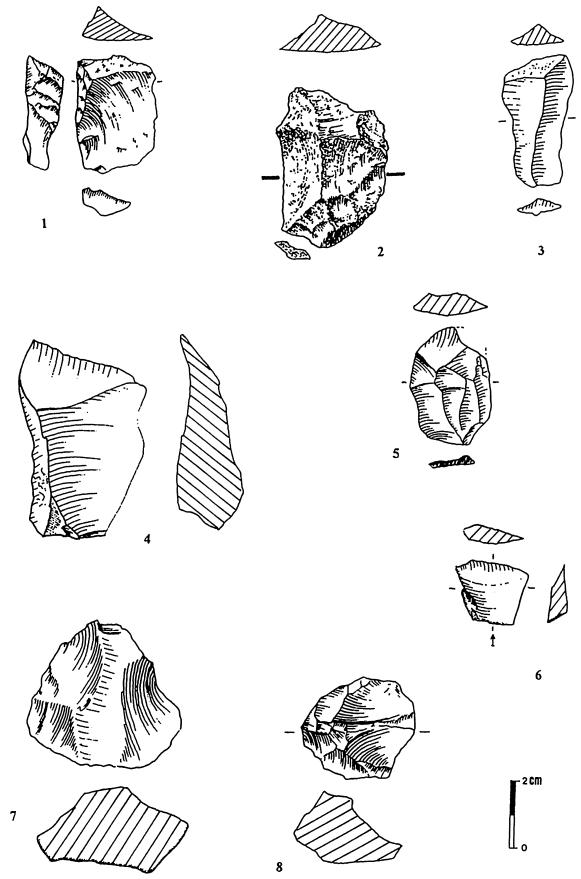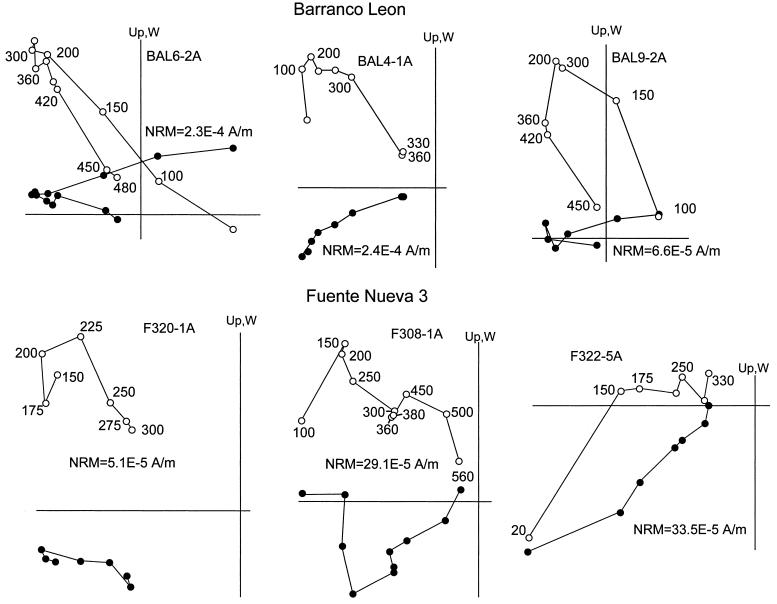Abstract
The lacustrine deposits infilling the intramontane Guadix-Baza Basin, in the Betic Range of Southern Spain, have yielded abundant well-preserved lithic artifacts. In addition, the lake beds contain a wide range of micromammals including Mimomys savini and Allophaiomys burgondiae and large mammals such as Mammuthus and Hippopotamus together with the African saber-toothed felid Megantereon. The association of the lithic artifacts along with the fossil assemblages, themselves of prime significance in the Eurasian mammal biochronology, is providing new insight into the controversy of the human settlement in Southern Europe. Despite the importance of the artifacts and fossil assemblage, estimates of the geological age of the site are still in conflict. Some attempts at dating the sediments have included biochronology, uranium series, amino acid racemization, and stratigraphic correlation with other well-dated sections in the basin, but so far have failed to yield unambiguous ages. Here we present paleomagnetic age dating at the relevant localities and thus provide useful age constraints for this critical paleoanthropological and mammal site. Our data provide firm evidence for human occupation in Southern Europe in the Lower Pleistocene, around 1 mega-annum ago. The current view of when and how hominids first dispersed into Europe needs to be reevaluated.
Evidence for the oldest hominid settlement in Europe remains highly contentious because of the absence of an accurate chronostratigraphic framework for Lower to Middle Pleistocene sites. Present evidence suggests that the earliest species of Homo emerged about 2.5 mega-annum (Ma) ago in Africa, perhaps in response to climatic changes toward cooler and drier conditions. Homo ergaster migrated to Asia, becoming Homo erectus during the process, as evidenced by the paleoanthropological sites at Longgupo (China) (1), and Java (2). Although initially dated as 1.6–1.8 Ma old, both of these sites are strongly contested and they could be as young as 1 Ma (3). At the gates of Europe, excavations in Dmanissi (Georgia) have yielded Oldowan lithic industry associated with a jaw and crania of probably H. aff. ergaster, in alluvial deposits. A basalt layer that is overlain by the sediments containing human remains gave a 40Ar/39Ar date of 1.85 ± 0.01 Ma, whereas the sediments give reversed (Matuyama) polarity (4), constraining the date to lie between 0.78 and 1.77 Ma. Additional evidence (especially the faunal assemblage) places the Dmanissi site around the Pliocene-Pleistocene boundary, with an age slightly younger than 1.77 Ma. Also in the Caucasus, the Akhalkalaki site has yielded an Acheulean industry and a faunal assemblage that suggest an age slightly younger than Dmanissi (5). In Western Europe, dates are even more problematic, and until the early 1990s there had been no convincing documentation of human presence older than 0.5 Ma. Localities such as Le Vallonet (6, 7), Soleilhac (France), Isernia La Pineta (8) (Italy), and Atapuerca (Spain) (9, 10) are older than 0.5 Ma and are known to contain Oldowan tools. In any case, the genus Homo was ready to occupy various regions of the Old World at about 1 Ma, as indicated by the eastern Mediterranean sites at Ubeidiya (11) and Gesher Benot Ya'aqov (Israel) (12), both containing Acheulean tools. Within this setting of technology dispersal, Spain, at the cul de sac of Europe, plays a relevant role, as it seems to hold the oldest occupation evidence in Western Europe. The Iberian Peninsula appears to have been populated substantially earlier than northern and central Europe as evidenced by the human fossils and lithic objects recently found in Atapuerca (Northern Spain) that are about 0.8 Ma old (10,13). Another archaeological region in Spain, the Guadix-Baza (GB) Basin, has long been known for its number of fossiliferous levels, but there is a lack of adequate chronology of the strata containing the fossils. Dating techniques such as electron spin resonance and thermoluminescence cannot be satisfactorily applied in the strata that contain the archaeological remains because of the absence of the required minerals for such techniques. Here we report a paleomagnetic age at the localities where artifacts and fossils are found and provide firm age calibration of this important paleoanthropological and mammal site.
Barranco León (BL) and Fuente Nueva Stratigraphic Sections
The GB Basin is an intramontane basin situated in the Betic Cordillera, a mountain belt formed during the latest stages of the Tethys ocean closure caused by the convergence of the African and European plates during the Tertiary. It covers some 3,000 km2 and is located in a depression controlled by a set of northwest-southeast and north-northeast-south-southwest trending normal faults (14). The sedimentary strata are generally flat lying, with only very local deformation. A marine infill of the basin initiated during the late Miocene, after the dismantling of the North-Betic Strait, an ancient seaway between the Atlantic and the Mediterranean domains (15). A continental infill began toward the end of the Miocene and continued throughout the Pliocene and Pleistocene (16). At the end of the Miocene, the basins located in the central sector of the Betic Cordillera remained cut off from the sea and developed a paleogeographic pattern of axial and transverse drainage systems corresponding to different types of alluvial fans and fan deltas (16, 17). At times, the progradation of the transverse fans obstructed the master drainage, leading to partial occupation of the axial valley by ephemeral lakes. Climatic changes during the last 7 Ma modulated the variations in size of the lakes (15). The continental sediments can be divided into marginal and distal domains. The Guadix Formation is the most important marginal domain and consists of fluviatile sediments, whereas the Baza Formation (containing the archaeological sites of this study) consists of lacustrine sediments and is the most prominent distal domain.
The two Paleolithic sites studied [BL and Fuente Nueva 3 (FN3)] are located in the northeast of the GB Basin, near the town of Orce (Fig. 1), along tributary creeks of the Orce River. Both sites are located in the “Silty Calcareous Member” of the Baza Formation (18), which is dominated mainly by limestones, carbonate silts, and dark mudstones. Anadón et al. (19) conclude that this unit was deposited in a lake with an alternation of slightly saline and saline waters. The archaeological levels within the stratigraphic column are indicated in Fig. 2. The stratigraphic section at FN3 consists of a succession of limestones, white calcareous silts and mudstones with three fossiliferous levels: level 1 is a 2- to 5-cm thick layer of fine grained sand with abundant bones and large mammal teeth, without lithic artifacts; level 2 is 2 to 5 cm thick with abundant lithic tools; and level 3 is a carbonate layer with abundant fauna and lithic artifacts. At BL, the stratigraphic sequence comprises limestone, sandstone, gravel, calcareous silt, and dark mudstone. The Paleolithic level is a 35-cm thick layer of fine grained sands overlaying a bed of silt with root traces. Unfortunately, lateral facies changes are significant throughout the GB Basin, hampering physical correlation between strata from these two locations. The situation of BL may be stratigraphically slightly below that of FN3 (20). Recent field work at both sites enlarged the artifact record to more than 100 pieces (21–23) (Table 1; Fig. 3). The lithologic study at BL shows a marked difference between the pebbles (limestone, chert, dolomitic limestone, etc.), originating in relatively high-energy environments, and the material of the archaeological level (flint, which is clearly a lithic artifact), showing the anthropic nature of the objects. All local flint shows traces of intentional percussion. The platforms of the flakes are often cortical, plane (or flat) slope, and rarely faceted. In these sites, the objective of the lithic production was to make flakes. Flaking debris (débitage) are made in a simple way, and there is centripetal production for cores and supports. They show an absence of any trace of preparation. At FN3, the lithic artifacts were found in the surface-mixed sediment and the two lower archaeological levels. In this site, the sedimentation indicates a low-energy environment. This situation thus excludes the presence of geofacts. The absence of tooth marks and the near absence of carnivores exclude predator activity in the accumulation of the fauna. Among 54 artifact pieces from the mixed (upper) sediment, 45 have traces of red sediment on their surface, similar to those artifacts found in archaeological level 2. This fact would suggest that these 45 pieces derive from this level. All of the lithic assemblage is homogeneous so far as the raw material and technical procedures are concerned. In level 2, the initial technological observations indicate that all of the operational chain of manufacture is present. The material is composed of small flakes and debris, and the lithic artifacts are made of small chert pebbles (10–15 cm). All aspects of a lithic assemblage and its fabrication, including both core removals and cores themselves, are present. The manufacturing technique was exclusively by (hammerstone) percussion, including double bulb (bipolar) and the Siret-type accidents. The striking platforms are often cortical or plane, rarely with facets and sometimes convex with multiple faces. The workmanship produced flakes that were mostly transformed into trimmed pieces.
Figure 1.
Geological sketch map of the GB Basin and location of the stratigraphic sections studied, BL and FN3.
Figure 2.
Stratigraphic sections at BL and FN3 showing the locations of paleomagnetism samples, mammal sites, and archaeological sites. The corresponding Fisherian mean VGP latitudes also are shown.
Table 1.
Summary of the lithic artifacts at FN3 and BL
| Level | Flakes < 2 cm or debris | Flakes | Cores | Trimmed pieces | Other tools | Total |
|---|---|---|---|---|---|---|
| FN3 | ||||||
| Mixed | 22 | 11 | 3 | 15 | 3 | 54 |
| Level 1 | 2 | — | — | — | — | 2 |
| Level 2 | 29 | 10 | 1 | 5 | 4 | 49 |
| Level 3 | 1 | 1 | 1 | — | — | 3 |
| BL | 44 | 27 | 4 | 13 | 19 | 107 |
Figure 3.
Lithic artifacts excavated from BL and FN3. Artifacts 1–6: Flakes (1–3 from FN3; 4–6 from BL). Artifacts 7 and 8: Cores (7 from BL; 8 from FN3).
Multiple technical modalities are represented: production of laminar flakes, centripetal (core) flake production, and flake production using opposed surfaces for removals.
Paleomagnetic Dating and Biostratigraphy
Paleomagnetic analysis was carried out at the University of Michigan and the Institute of Earth Sciences in Barcelona. Oriented samples were measured with a shielded three-axis SQUID magnetometer with a noise level of 8 × 10-6 A/m, well below the natural remanent magnetization intensity of the analyzed samples. Stepwise thermal and alternating field demagnetization procedures were used to eliminate the overprint of the present-day magnetic field and to isolate the characteristic remanent magnetization (ChRM). Remanence directions were calculated by principal component analysis (24) of linear demagnetization vectors picked from paleomagnetic orthogonal projection plots (Fig. 4) (25). The ChRM directions then were used to derive the virtual geomagnetic pole (VGP) latitudes for each sampling site. The thermal procedure proved to be more effective in defining the magnetic components. A total of 110 samples were analyzed, and 65 ChRM directions have been used to determine the magnetic polarity. The remaining samples showed unstable magnetization during demagnetization and failed to give a stable ChRM. The presence of a strong normal overprint is evident in most of the samples and is usually removed at, or before, 300° Celsius. A similar magnetic behavior has been observed in other stratigraphic sections within the GB Basin, where rock-magnetic analyses indicate the presence of a low-coercivity mineral (magnetite) in the mudstones (26). Both sections display VGP latitudes ranging between −2 and −86°, thus reflecting a reverse geomagnetic field during the time of sediment deposition.
Figure 4.
Typical examples of orthogonal thermal demagnetization plots in geographic coordinates from six samples from the BL and FN3 sections. ○ indicate projections onto the vertical plane. ● indicate projections onto the horizontal plane. Demagnetization temperatures are given in degrees Celsius. NRM, natural remanent magnetization intensity.
The faunal material from FN3 includes Mammuthus meridionalis, Hippopotamus antiquus, Stephanorhinus etruscus, Equus altidens, Megaloceros solihacus, Cervus sp., Bovini, Hemitragus sp., Megantereon whitei, Ursus sp., Hystrix major, Allophaiomys bourgondiae, Allophaiomys chalinei, and Mimomys (27), an assemblage of Lower Pleistocene type, and is totally distinct from those of the Middle Pleistocene and Upper Pliocene. The macromammals of FN3 correspond to those of the Venta Micena site, situated some 3 km away in the same basin. Venta Micena also displays reversed magnetization and the fossil record, which is larger and more widely known (28, 29) than FN3, is similar to that of Dmanissi (30), Apollonia-1 (31), and Ubeidiya (32). The arvicolid, A. bourgondiae, presents a morphology similar to some samples from Monte Peglia B (Italy) described by Van der Meulen (33), whereas A. chalinei displays a primitive morphology, with enamel differentiation of the Mimomys type. The micromammal assemblage at Le Vallonet (Southern France) contains examples of Microtus nivaloides that are more evolved than A. bourgondiae of FN3 (27). Also, the Gran Dolina archaeological site TD6 (Atapuerca, Spain) contains examples of M. nivaloides (34) in sediments that have reversed (Matuyama) polarity (10). A. bourgondiae in FN3 is an older species than M. nivaloides in Le Vallonet and indicates that the former site is older than the latter. Thus, FN3 might record stone tools that are older than TD6 (Atapuerca), so far the oldest well-documented hominid site in Western Europe.
The vertebrate fauna at BL also points to an earliest Pleistocene age (having Castillomys crusafonti spp., Apodemus mystacinus, A. aff. sylvaticus, Eliomys intermedius, Mimomys sp., Allophaiomys pliocaenicus, Oryctolagus cf. lacosti, cf. Homotherium sp., Equus sp., Megaloceros sp., Cervidae gen. et sp. indet., Bovini gen. et sp. indet., Hemitragus alba, Soergelia minor, Hippopotamus antiquus, Mammmuthus meridionalis, and Bovini indet.) (35).
Implications of the Magnetochronology
Several conclusions can be drawn from the paleomagnetic and biostratigraphic records at both BL and FN3. First, the presence of exclusively reverse magnetization throughout the stratigraphic sections, combined with the faunal assemblages, indicates a Matuyama age for the archaeological sites (0.78–1.77 Ma), i.e., Lower Pleistocene. The age estimate is derived directly from the sediments containing the lithic industry, thus removing any uncertainty related to stratigraphic inference by extrapolation to other sections in the basin. Second, the presence of M. nivaloides in Le Vallonet, in sediments with normal polarity (6) ascribed to the Jaramillo subchron (0.99–1.07 Ma), a younger species than A. bourgondiae in FN3, might indicate that the stone tools at FN3, within the reverse Matuyama Chron, are older than 1.07 Ma. This inference needs further investigation. Finally, the presence of lithic industry older than 0.78 Ma, and probably older than 1 Ma in southern Spain, combined with the presence of hominids dated between 0.5 to 1.07 Ma in Western Europe (e.g., Le Vallonet, Isernia La Pineta, Gran Dolina), raises the issue of the age of the earliest colonization of Europe. Some authors (36) primarily have fostered a model of a belated occupation of Europe as the “short chronology.” Those authors argue that the earliest colonization of Europe is some 0.5 Ma old (“Mauer” time), based on the numerous Middle Pleistocene evidence for occupation all over Europe. Nevertheless, a model of an earlier occupation of Europe (“Mature Europe”) was supported by Carbonell et al. (37) to explain the presence of humans there at about 1 Ma ago. A number of European localities considered between 0.5 Ma and 1.07 Ma in age yield lithic industries considered to represent Oldowan technology (although the precise age is often still a matter of debate); they include Korolevo, Le Vallonet, Soleilhac, Isernia La Pineta, and Gran Dolina. Along with the Atapuerca archaeological site TD6 (>0.78 Ma), the BL and FN3 sites, dated here as older than 0.78 Ma and probably older than 1.07 Ma, afford consistent evidence favoring the hypothesis that Western Europe was peopled at least as early as the late Lower Pleistocene. Recent discoveries at the site of Dmanissi support our hypothesis (4).
Acknowledgments
We are very grateful to Prof. F. Clark Howell for coordinating the revision of the manuscript. We also thank M. E. Evans, N. D. Opdyke, and L. G. Straus for critically reading the manuscript and E. Essene, J. Kappelman, C. Langereis, R. Van der Voo, and T. Van Kolfschoten for their comments on an earlier version of the manuscript. This study is supported and has official authorization by the Consejería de Cultura de la Junta de Andalucía of Spain. B.M.N. is the recipient of grants from the Leakey Foundation and the Irene Levi Sala Care Archaeological Foundation. Research was also partially supported by the Dirección General de Enseñanza Superior and the University of Michigan.
Abbreviations
- Ma
mega-annum
- GB
Guadix-Baza
- BL
Barranco León
- FN3
Fuente Nueva 3
- VGP
virtual geomagnetic pole
Footnotes
Article published online before print: Proc. Natl. Acad. Sci. USA, 10.1073/pnas.180319797.
Article and publication date are at www.pnas.org/cgi/doi/10.1073/pnas.180319797
References
- 1.Wanpo H, Clochon R, Yumin G, Larick R, Qiren F, Schwarcz H, Yonge C, de Vos J, Rink W. Nature (London) 1995;378:275–278. doi: 10.1038/378275a0. [DOI] [PubMed] [Google Scholar]
- 2.Swisher C C, III, Curtis G H, Jacob T, Getty A G, Suprijo A, Widiasmoro Science. 1994;263:1118–1121. doi: 10.1126/science.8108729. [DOI] [PubMed] [Google Scholar]
- 3.Langbroek M, Roebroeks W. J Hum Evol. 2000;38:595–600. doi: 10.1006/jhev.1999.0394. [DOI] [PubMed] [Google Scholar]
- 4.Gabunia L, Vekua A, Lordkipanidze D, Swisher C, III, Ferrign R, Justus A, Nioradze M, Tvalchrelidze M, Anton S, Bosinski G, et al. Science. 2000;288:1019–1025. doi: 10.1126/science.288.5468.1019. [DOI] [PubMed] [Google Scholar]
- 5.Vekua A. Paleontogr Ital. 1986;74:63–99. [Google Scholar]
- 6.Gladiline V, Sitlivy V. In: Les Premiers Européens. Bonifay E, Vandermeersch B, editors. Paris: Comité des Travaux Historiques et Scientifiques; 1991. [Google Scholar]
- 7.Yokoyama Y, Bibron R, Falgueres C. L'Anthropologie. 1988;92:429–436. [Google Scholar]
- 8.Coltorti M, Cremaschi M, Delitala M C, Esu D, Fornaseri M, McPherron A, Nicoletti M, Van Otterloo R, Peretto C, Sala B, et al. Nature (London) 1982;300:173–176. [Google Scholar]
- 9.Carbonell E, Bermudez de Castro J M, Arsuaga J L, Diez J C, Rosas A, Cuenca-Bescos G, Mosquera M, Rodriguez X P. Science. 1995;269:826–830. doi: 10.1126/science.7638598. [DOI] [PubMed] [Google Scholar]
- 10.Parés J M, Pérez-González A. Science. 1995;269:830–832. doi: 10.1126/science.7638599. [DOI] [PubMed] [Google Scholar]
- 11.Bar-Yosef O. J World Prehistory. 1994;8:211–265. [Google Scholar]
- 12.Goren-Inbar N, Saragusti I. J Field Archaeol. 1996;23:15–30. [Google Scholar]
- 13.Falgueres C, Bahain J J, Yokoyama Y, Arsuaga J L, Bermudez de Castro J M, Bischoff J, Dolo J M. J Hum Evol. 1999;37:343–352. doi: 10.1006/jhev.1999.0326. [DOI] [PubMed] [Google Scholar]
- 14.Sanz de Galdeano C, Vera J A. Basin Res. 1992;4:21–36. [Google Scholar]
- 15.Soria J M, Viseras C, Fernández J. Geol Mag. 1998;135:565–574. [Google Scholar]
- 16.Viseras C, Fernández J. J Geol Soc (London) 1992;149:1021–1029. [Google Scholar]
- 17.Fernández J, Viseras C, Bluck B J. Publicacions del Servei Geològic de Catalunya. Barcelona: Servei Geològic; 1991. [Google Scholar]
- 18.Vera J A, Fernández J, López-Garrido A C, Rodriguez-Fernandez J. Paleontologia i Evolucio. 1985;18:3–11. [Google Scholar]
- 19.Anadon P, De Deckker P, Julia R. Hydrobiologia. 1986;143:199–208. [Google Scholar]
- 20.Oms O, Agustí J, Gabas M, Anadón P. J Quat Sci. 2000;15:43–50. [Google Scholar]
- 21.Gibert J, Gibert L, Iglesias A, Maestro E. Antiquity. 1998;72:17–25. [Google Scholar]
- 22.Tixier J, Roe D, Turq A, Gibert J, Martínez-Navarro B, Arribas A, Gibert L, Gaete R, Maillo A, Iglesias A. C R Acad Sci. 1995;321:71–78. [Google Scholar]
- 23.Turq A, Martínez-Navarro B, Palmqvist P, Arribas A, Agustí J, Rodriguez Vidal J. Paleo. 1996;8:161–204. [Google Scholar]
- 24.Kirschvink J L. Geophys J R Astron Soc. 1980;62:699–718. [Google Scholar]
- 25.Zijderveld J D A. In: Methods in Paleomagnetism. Collinson D W, Runcorn S K, Creer K M, editors. New York: Elsevier; 1967. pp. 254–286. [Google Scholar]
- 26.Oms O, Dinarès-Turell J, Agustí J, Parés J M. Quat Res. 1999;51:94–103. [Google Scholar]
- 27.Martínez Navarro B, Turq A, Agustí J, Oms O. J Hum Evol. 1997;33:611–620. doi: 10.1006/jhev.1997.0158. [DOI] [PubMed] [Google Scholar]
- 28.Martínez-Navarro B. Ph.D. dissertation. Spain: Universitat Autonoma de Barcelona; 1991. [Google Scholar]
- 29.Palmqvist P, Martínez-Navarro B, Arribas A. Paleobiology. 1995;22:514–534. [Google Scholar]
- 30.Vekua A. Jarhb Röm Ger- Zentralmuseum Mainz. 1995;42:77–180. [Google Scholar]
- 31.Kostopoulos D. Geodiversitas. 1997;19:845–875. [Google Scholar]
- 32.Tchernov E, editor. Les mammifères du Pléistocène inférieur de la Vallée du Jordain a Oubeidiyeh: Mémoires et Travaux du Centre de Recherche Français de Jerusalem. Paris: Association Paleoriental; 1986. [Google Scholar]
- 33.Van der Meulen A. Quaternaria. 1973;17:1–144. [Google Scholar]
- 34.Cuenca-Bescós G, Laplana C, Canudo J I. J Hum Evol. 1999;37:353–373. doi: 10.1006/jhev.1999.0306. [DOI] [PubMed] [Google Scholar]
- 35.Agustí J, Moyà-Solà S, Martin-Suarez E, Marin M. Paleont Evol Mem Esp. 1987;1:73–86. [Google Scholar]
- 36.Roebroeks W, Van Kolfschoten T. In: The Earliest Occupation of Europe. Roebroeks W, Van Kolfschoten T, editors. Leiden: University of Leiden; 1995. pp. 297–315. [Google Scholar]
- 37.Carbonell E, Mosquera M, Rodriguez X P, Sala R. J Anthropol Res. 1995;51:107–114. [Google Scholar]






